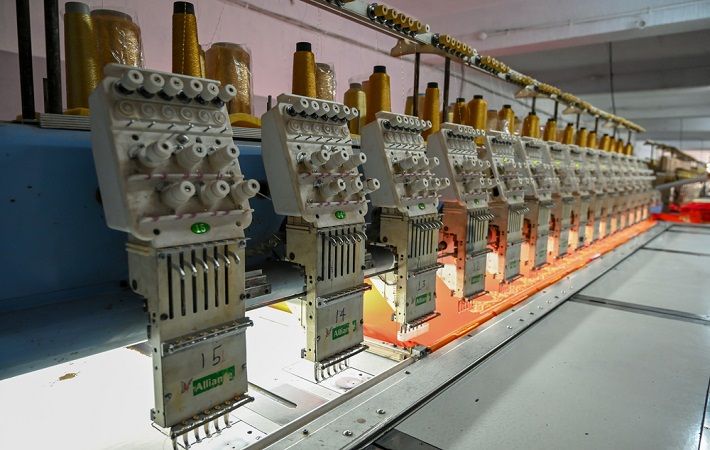
By Nischal Sanghavi
The textiles industry in Gujarat was severely hit last year—first due to the lockdown, and then by the migration of thousands of workers. And just as things were beginning to get back on track, the explosion of COVID-19 cases in the state has now virtually crippled the industry.
According to the Federation of Surat Textile Traders Association (FOSTTA) president Manoj Agarwal, the industry has already suffered a loss of ₹6,000 crore. The Federation of Gujarat Weavers’ Welfare Association (FOGWA) president, Ashok Jirawala, puts the daily loss at ₹37.5 crore. The way COVID-19 cases have been mounting, as also the deaths, the losses are expected to shoot up.
Agarwal says production is down by over 40 per cent. Lots of workers have returned to their home states fearing another lockdown, while some have gone back for the ensuing wedding season. “Our main markets are Maharashtra and Madhya Pradesh. Almost all the states have lockdown-like measures due to the second wave of the pandemic. Inter-state business travelling is at a standstill. This alone has brought down business by 20 per cent. Retail shops are open from 10 am to 6 pm, but there aren’t many customers. Our market is dependent on wedding shopping. However, weddings are being organised on very low scales, and so spending on clothes has drastically reduced.”
According to Ashok Jirawala, “There are 15 lakh to 17 lakh workers employed in and around Surat in different processes of textile production like weaving, threading, processing, etc. The industry has a production capacity of 4.5 crore metres of cloth on a normal day. Right now, the situation is such that 40–45 per cent workers have already left Surat. So, the daily production has dropped to 2 crore metres. At ₹15 per metre, this works out to a daily loss of ₹37.5 crore. The way things are going, another 20 per cent workers would go back to their native land in the next one month. The huge effect of the pandemic is just not on the textiles industry, but the economy of the entire region.”
The president of Surat Autoloom Weavers Association (SAWA), Sanjay Desai, says that there are 50,000 people working in the 750 waterjet autolooms in Surat district. Due to the pandemic, the units are currently working at 50 per cent utilisation. Last year, the units had remained completely closed due to the countrywide lockdown. “We are still hoping that there will not be any lockdown and the workers who are currently working would continue to do so. Prime Minister Narendra Modi’s speech on Tuesday was beneficial in a way. He clearly stated that there would not be any lockdown. This will give some confidence to workers and many would stop considering migrating back to their homeland.” There is not much effect of night curfew on production.
Dipak Sheth, president of the Yarn Broker Association (YBA), says that their association has 450 yarn brokers as members who connect weavers to yarn manufacturers. Over 1 lakh workers mostly from Odisha, Bihar and Uttar Pradesh work in the yarn manufacturing sector. Currently, all units are working at half the capacity as 50 per cent workers are absent. Last time, during the lockdown, workers faced problems in getting transport to return to their hometowns due to the sudden rush. This time, to avoid such a situation, many workers are travelling back in advance.” Sheth is also a committee member with the South Gujarat Chamber of Commerce and Industry (SGCCI).
There are about 1,400 textile units in and around Jetpur town in Rajkot district who are engaged in cotton fabric printing. The printed cotton is used in garments and sent to African countries apart from catering to the domestic demand. According to Jayantibhai Ramolia, president of the Jetpur Printing and Dyeing Association (JPDA), workers mainly from Jharkhand, Uttar Pradesh and Bihar work at the Jetpur units. “Last year we had lost more than one and a half month of production. After that, the demand dipped due to market recession. This time, the workers have not left us but we are facing a low market demand. Our business line passes through Mumbai, which has been severely affected by COVID-19. The Mumbai offices are working partially, and logistics are slow. We also run a business line through Kolkata. However, due to the elections in West Bengal, it is also slow right now. This period is the peak season for cotton fabric, but the demand this year is very sluggish. We keep factories closed for two days of the weekend to protect people against infection as far as possible.”
The overall situation is dismal. Says Jirawala, “We don’t know whether or how the government will be able to help us confront this situation. The least that the government can do is to release our money that they have been sitting on since long time. Input credit worth ₹600 crore is yet to be paid by the government to the textile units. In these difficult times, if the government is not giving us our own legitimate dues, what more can we ask for? It is important to note that even the high court has ordered the payment of this money, but it is still pending from the government.”
Fibre2Fashion News Desk (WE-NS)